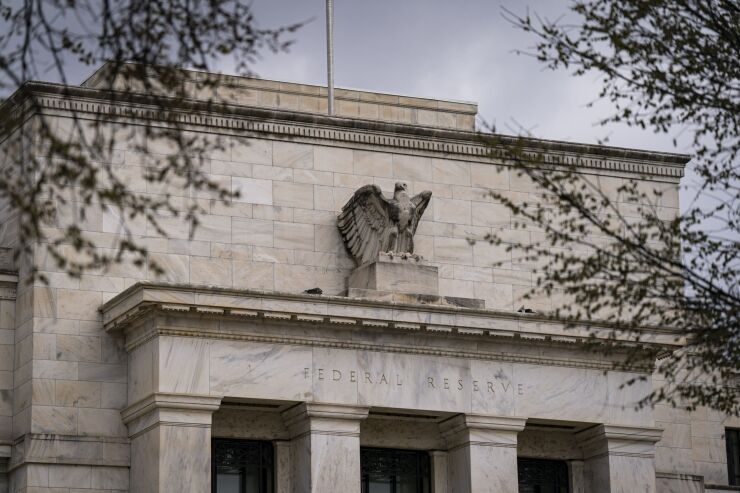
Inflation slowed faster than expected last month, potentially giving the Federal Reserve space to lower interest rates should economic shakiness lead to sudden job losses.
The Consumer Price Index declined 0.1% on a month-to-month basis and was up just 2.4% year over year, the smallest annualized increase since March 2021 and down from February's 2.8% increase.
The reading, released by the Bureau of Labor Statistics on Thursday morning, beat market forecasts, which called for a 0.1% monthly increase for a yearly uptick of 2.6%.
The decline in headline inflation was largely driven by lower energy costs, particularly gasoline, which were down 9.8% over March 2024. Core CPI, which factors out energy and food prices, was 3%, in line with market expectations.
The report comes at a time of heightened economic uncertainty, with markets, businesses and consumers reeling from last week's sweeping
Read more of American Banker's
Trump put many of those concerns at bay yesterday when he announced a
Corporations, households and investors are not the only ones struggling to make plans in this environment. Federal Reserve officials have also struggled to get a clear view on the economy's trajectory and come up with a monetary policy response.
Last week, Fed Chair Jerome Powell said the tariffs announced by Trump were
"It's just too soon to say what the appropriate monetary policy response to these new policies will be," Powell said. "Fast forward a year from now, the uncertainty will be much lower and the effects of the policies will be clear."
In the wake of Trump's pause, Fed officials maintained their cautious stance toward policymaking. In an interview on CBS News on Wednesday, Federal Reserve Bank of Minneapolis President Neel Kashkari said the pause provided only a temporary reprieve from volatility and no additional clarity.
"The analysis on the inflation impacts of tariffs, you may bring that down a little bit if this pause endures, but right now we're still in a highly uncertain environment," Kashkari said. "And so I hope we can get to a place where there's enduring clarity for markets and for investors, and also for central bankers, as we're trying to figure out the path of monetary policy."
In an essay earlier that day, Kashkari said no policy option should be off the table, noting that the Fed could cut interest rates if the uncertainty triggers significant job losses or raise them if tariffs kick off a fresh round of inflation. But, he noted, that adjusting either way will require a clear data signal on the direction of the economy.
"In my view, the hurdle to change the federal funds rate one way or the other has increased due to the tariffs," he wrote.
For now, Federal Open Market Committee members are looking at how all of the new administration's positions — including trade, immigration, fiscal and regulatory policies — impact the economy as a whole.
In a speaking engagement at Brigham Young University in Provo, Utah, Federal Reserve Bank of San Francisco President Mary C. Daly said there are elements of the Trump agenda that could weigh on economic activity, other elements — namely deregulation and tax cuts — could induce more demand. Because of this, she said she is still looking to understand the net effect of all the changes.
"Jumping to a conclusion in a period of such uncertainty is a recipe for making a mistake," Daly said. "So, as a policymaker, I don't take bets. I look at the data."
Federal Reserve Bank of Richmond President Tom Barkin, speaking Wednesday at an event hosted by the Economic Club of Washington, said when it comes to the Fed's dual mandate, preventing inflation and maintaining maximum employment, officials give equal weight to both their responsibilities.
But, Barkin said that keeping inflation — and inflation expectations — low gives policymakers more flexibility in addressing both mandates.
"if you've got price stability you can do more to help on the employment side. If you don't have price stability you can do less on the employment side," he said. "If you see inflation expectations start to move up, that gives you a lot fewer degrees of freedom than if you've got very anchored inflation expectations."






